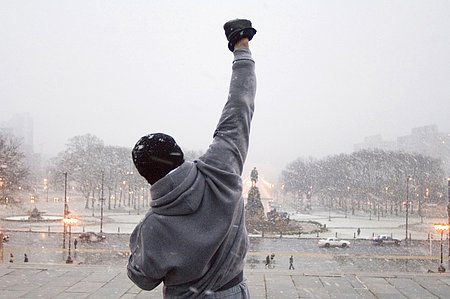I love great, transcendent cinema (obviously), but I also love watching good old movie-movies. “Raging Bull”? Genius. Rocky IV? Dumb as a brick, but ridiculously entertaining! In other words, I was totally psyched to see Sylvester Stallone don the Italian Stallion’s trunks one last time, for my own guilty pleasure. I expected the film to be ridiculous, which it kind of is. I expected it to be a nostalgia piece, which it definitely is. What I didn’t quite expect was how heartfelt and, I’m not kidding you, touching it is.
“It ain’t about how hard you hit… It’s about how hard you can get hit, and keep moving forward.”
A simple, maybe even simplistic philosophy but damn it, it got to me! Not that I took that many hits in my life, but I like to believe that I have the will to push through whatever comes my way. Trying hard now, getting strong now, GONNA FLY NOW! Is there anyone that doesn’t get at least a small tingle when they hear Bill Conti‘s classic theme, with those triumphant horns, funky guitars and spacey keyboards? I doubt it. Even the crustiest film snob must get the impulse to pump his fists in the air and root for the ultimate underdog that is Rocky.
Because when you get right down to it, these flicks ain’t even about boxing all that much. Sure, the testosterone got pumped up to almost obscene amounts in the ’80s sequels, but “Rocky Balboa” is a return to the basics of the original, more character study than action movie. Seriously, it takes more than an hour before Rocky even decides to put the gloves back on! Before that, it’s all about establishing where our once great hero is at right not, which isn’t very pretty. Since we last saw him, Balboa has lost his Adrian to “the woman cancer” and his son (now played by the perfectly cast Milo Ventimiglia, i.e. Jess from “Gilmore Girls”), tired of living in his old man’s shadow, has grown distant from him. Rocky is left somewhat pathetically hanging on to his past glory, spending most of his time either telling stories about his famous fights to the customers of his restaurant or sulking over his wife’s grave and the other places around South Philly that remind him of her.

This is all pretty sappy, with not always well integrated flashbacks, dialogue that’s a bit too on the nose and a really cheesy chick song (not sure who it’s from, sounds like Christina Aguilera or something). Thankfully, we got Burt Young‘s eternally grumpy Paulie taking the piss out of Rocky through this, so we know the movie ain’t taking itself too seriously. More so, while Stallone is hardly the best actor in the world, I found him surprisingly endearing here in Papa Bear mode. Plus, Sly knows this character inside and out, heck, he practically IS that character! He’s written all the Rockys, too, and you can tell that this material is personal to him — maybe not the Clubber Lang and Ivan Drago stuff, but at least the first film and this last one, which nicely mirrors it. Whereas “Rocky” was about a nobody whom no one believed in, “Rocky Balboa” is about a has-been whom no one believes in anymore — same difference. When Rocky says he wants one last chance, to show he’s “still got something left in the basement”, this could be Stallone himself talking. He’s become a joke too, but he’s still standing and making movies, to the risk of falling on his face. You gottta admire that, at least.
I also enjoyed the understated sorta-romance our widowed fighter timidly gets into with a barmaid (Geraldine Hughes), who has a half-Jamaican son (James Francis Kelly III) whom Rocky also takes an interest in. Ok, that sounds odd, but it mostly works, if only for balancing out how the rest of the film uncomfortably opposes Balboa’s old-fashioned Italian-American family values and the hip hop / bling bling arrogance of current heavyweight champion Mason “The Line” Dixon (Antonio Tarver).
And then there’s the fight and, even more importantly, the training montage preceding it! Again, whatever you’ve been thinking of the movie up until then, when the Conti theme blares on and Rocky starts lifting weights, punching meat and running up the front steps of the Philadelphia Museum of Art, there’s no way you won’t be grinning like an idiot! I wish I could say that the big fight is equally satisfying, but it’s adequate at best. Stallone intentionally went for realism, with choppy, shaky shots that look like a TV retransmission, which is fine, I guess, but not as rousing as a more over the top movie fight could have been. I did like the flashes and the little B&W bits with bursts of color, though.
So there you have it: “Rocky Balboa” is not great, transcendent cinema, but it’s much less ridiculous than it could have been. It will certainly provide a lot of guilty pleasure to fans of the franchise and, if you’re like me, maybe even touch your heart.

